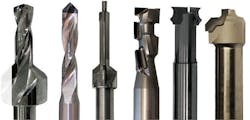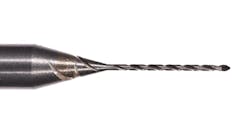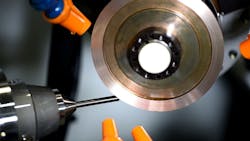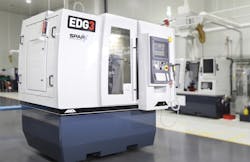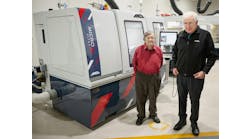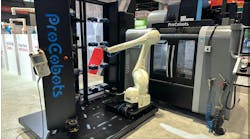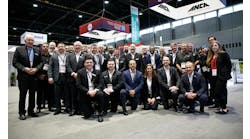ANCA manufactures CNC grinding machines. It was founded in 1974 in Melbourne, Australia, where the company still has its global headquarters. ANCA has offices in the United Kingdom, Germany, China, Thailand, India, Japan, Brazil and the United States. ANCA CNC grinders are used for manufacturing precision cutting tools and components across a range of industries including cutting tool manufacture, automotive, aerospace, electronics and medical.
When ANCA decided to create its Electro Discharge Grinding (EDG) machine in 2011, the mission was clear: The company wanted to design and build a high-performance rotary electro discharge machining (EDM) platform that was not only able to produce best-in-class tool geometries, but also have market-leading cycle times.
It was the brainchild of Pat Boland, ANCA founder and managing director, who realized that, to outperform the incumbents, brains were needed over brawn.
“The erosion process is simple in its complexity,” says Boland. “The basis of the process uses positive and negative electrodes with electrolyte to create sparks along a material. ANCA has a 45-year history in making the world’s best carbide and HSS tools, and we wanted to use that skill set in PCD tooling.”
The main drivers behind the ANCA EDG machines were that it needed to be simple enough for all types of brazed shear-fluted tools, but complex enough to enable the creation of the infinite variety of helical solid-tipped, veined and chevron tools.
“We realized early on that with the complexity of tool geometries we wanted to allow our customers to create the five-axis interpolation while maintaining the precise erosion gap distance was going to be a challenge,” explains Boland.
Maintain the optimum spark erosion gap with IAC
The ANCA EDG is able to maintain the optimum spark erosion gap for both simple 2D and complex 3D path interpolations, which is fundamental to the process working with high efficacy. This is very simple for 2D paths; however, when 3D path interpolation involves four or five axes moving simultaneously, surface area, volume and path variation become a challenge.
From testing, we knew that the standard was to set the machine feed rate to the lowest allowable to maintain a usable spark gap distance; however, this leads to a lot of “air time” and drastically lowers efficiency. To allow the feed rate to remain high and maintain the optimum spark erosion gap, the idea of intelligent adaptative control (IAC) was born.
IAC is an in-time, servo-controlled feature that automatically monitors and controls the erosion gap distance, in-process. Utilizing the EtherCAT functionality of the ANCA Motion AMD5x control system, IAC synchronizes the machine moves with the generator performance.
IAC adjusts and maintains the optimum spark gap, which is vital while eroding 3D geometries such as PCD flutes and gashes on drills and endmills. With geometry changing in up to five axes at once, IAC automatically adjusts the gap distance and machine feed rate to optimize the erosion speed and surface finish. This involves not only speeding up feed rates when erosion is along linear paths but also slowing down feed rates when path changes occur.
Twists and turns along the erosion path lead to scenarios where the electrode wheel is likely to come into close contact with the tool, or comes off the tool. This can lead to optimal, bad and missed sparks along the trajectory.
IAC automatically accounts for this and maintains the fastest possible feed rate along the length of any changeable path. This results in increased feed rates, minimum thermal damage, superior surface finish, increased material removal rate (MRR) and decreased cycle time.
An added benefit of IAC is the ease in which PCD and carbide micro-tools can be manufactured. Since IAC maintains the optimal distance, the chance of wheel collisions and hence tool breakage is very low which is critical when eroding tools under 0.5 mm.
Optimize the erosion process with ASC
The current, voltage, duration, time-off and therefore intensity of sparks changes based on the material that is being eroded. That is, PCD will require certain parameters as opposed to carbide (HM) and high-speed steel (HSS). The challenge is that PCD wafers are generally 0.6 mm PCD with a 1 mm carbide backing—sintered PCD, chevron tools and solid-tipped tools are formed onto carbide backing, also.
When aggressively eroding along the PCD-carbide border, erosion parameters optimized for PCD can inadvertently over-erode the carbide backing. This in turn leads to over-erosion at the PCD-carbide border, named an “undercut” as it selectively erodes the carbide under the PCD. Additionally, it can lead to cobalt leeching, which is when the PCD binder, cobalt, is preferentially eroded away.
This is akin to digging under the foundations of a paved pathway. If you dig too much material away from under the path, eventually the path will collapse. Machine testing showed that the undercut and cobalt leeching during heavy roughing lead to a brittle border along the cutting edge and premature tooling wear. To avoid this happening and to optimize the erosion process, adaptive spark control (ASC) was created (Figure 1).
Figure 1: Note the solid-tipped PCD drill.
ASC uses the digital signal processors (DSPs) and field-programmable gate arrays (FPGAs) on the generator itself. The EDG erosion generator is able to monitor and process every spark in real time.
The waveform of each spark is automatically monitored and categorized based on material being eroded, erosion gap distance and other factors essential to optimal erosion process. The generator can then dynamically adapt the energy level of each and every spark (current, voltage, duration and time-off) to suit the material being eroded.
ASC optimizes the erosion process leading to less cobalt leaching and a reduction in undercut at the PCD-carbide border. This leads to a stronger cutting edge and a finished tool that is less prone to chipping. This helps to achieve longer tool life, less tool wear and lower tooling costs. Testing on tooling suited to the machining of carbon fiber reinforced plastic (CFRP) showed a tool life increase of up to 100% (Figure 2).
Figure 2: This is a 0.4 mm solid-tipped PCD drill.
Boost the power electronics
ANCA leant on the expertise from its sister company, ANCA Motion to optimize the electronics to enable even higher and more aggressive erosion, all the while maintaining very high surface finish results. When compared to equivalent componentry, the “mega-amp per pulse” technology enables ANCA customers to broaden the power range they can access and utilize.
The ANCA Motion SparX Erosion Generator exhibits superior performance over the range of Extra-Heavy Roughing to Ultra-Fine Finishing operations, utilizing Pico-pulse technology for high energy-density ablation.
This enables vastly superior controllability, providing customers with optimized feed rates, superior surface quality and drastically reduced cycle times. This pulse precision allows erosion that ranges from ultra-low energy pulses for exceptional ultra-fine finishing through to high energy pulses for fast material removal (Figure 3).
Figure 3: In the PCD erosion process, cycle time is directly related to the material removal rate.
In the PCD erosion process, cycle time is directly related to the MRR. The ANCA Motion SparX Erosion Generator delivers increases in MRR utilizing the Extra-Heavy Roughing, Super Fine Finishing and Ultra-Fine Finishing operations. What this equates to is an increase in MRR and a 50% decrease in cycle time compared to competitor machines, arguably the fastest cycle times in the market. Additionally, erosion surface quality also sees an improvement across all power modes. Polished surface finishes of Ra < 0.1µm and Rz < 0.5µm can be achieved using the Ultra-Fine Finishing process with Pico-pulse technology. These operations enable the production of superior cutting edges necessary for the most demanding of cutting-tool applications.
Combining intelligence in a domain once dominated by brute force electronics not only gives ANCA customers an edge over the competition but enables a smarter approach to tool making (Figure 4). The difference between our approach and the approach of our competitors is that ANCA focuses on what our customers want to achieve with their erosion process.
Figure 4: Combining intelligence in a domain once dominated by brute force electronics not only gives ANCA customers an edge over the competition but enables a smarter approach to tool making.
They strongly told us that they wanted a process optimized for helical and round PCD tooling. We worked closely with ANCA Motion to design our erosion generator to suit not only shear tooling but the infinite array of highly complex geometries, rather than reusing generator technology originally created for wire electro discharge machining (Wire-EDM). Our approach turned the industry on its head. We let the geometries dictate the process, not the process dictate the geometries available. We used intelligence to outperform brute force.
ALSO READ: IIoT and remote connectivity let you keep your distance

Leaders relevant to this article:

